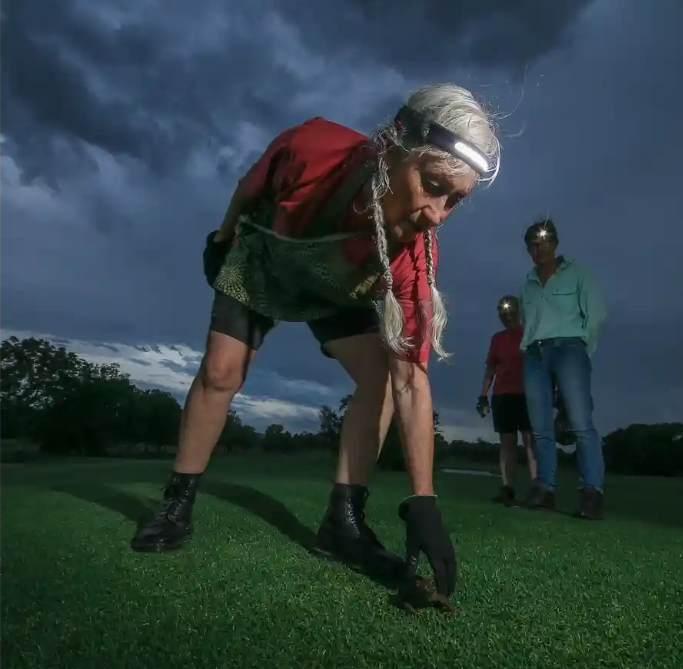January 27, 2023
With a plastic-lined shopping cart in the back and a head lamp in front, Linda Kimber marches into a farm as the sun sets to the southwest of Brisbane.
Jo Davies, who is walking in a similar direction but to her left, has a customised carrier of her own: a huge dog-biscuit bag strung on a rope with a downpipe offcut sticking out of its sealed top.
The last link in the human chain, carrying a bucket, is Joan Sheldon, standing to Kimber's right. The women painstakingly illuminate cowpats, puddles, and plants with their lights.
Stag hunts are held by European lords, while Inuit hunters pursue whales across waves and ice. Kimber is conducting a typically Queensland quest. These ladies are looking for toads.
It's not just them. A tiny army of Australian volunteers is starting the Great Cane Toad Bust, a week-long operation that will span three states and a territory.
It is a tournament that is now in its second year and is quite serious in the town of Boonah.
Kimber's team, WACT (Women Against Cane Toads), is the reigning regional winner after catching 928 of the district's 9,468 cane toads during the Bust last year.
Many of the women were first a little apprehensive, according to Kimber. But if you didn't have 150 toads, it became incredibly difficult to get home.
The cane toad, which was purposefully imported from Hawaii in the 1930s, has since become a symbol of an exotic species gone feral.
The invasive species kills predators that are unprepared for its poisons as it spreads and eats almost anything that will fit in its mouth. Furthermore, it is not simply causing extinction in other species.
Although the toad hasn't showed much interest in the cane bug that sugar producers had intended to eradicate, it does find the dung beetle to be delectable. As a result, there will be more cowpats left in paddocks, which will worsen the cattle's fly and parasite issues and reduce the amount of nutrients that are returned to the land.
When Chris Bonner recounts his feelings for the large, warty frog, he essentially speaks for every Queenslander who lives on the property where the ladies go hunting.
It's the number one adversary of the people, adds Bonner.
Cane toads have been seen to create writhing carpets on the front lines of their advance into Western Australia and New South Wales.
But the toad and toad busting have been well-established throughout Queensland's eastern shore for decades.
If you hadn't struck a few toads with a golf club, you wouldn't be a kid in Queensland, claims Kimber.
But she doesn't support or tolerate such nasty tactic. Her hunters only kill their prey using the fridge-freezer method, which is the most merciful technique.
The cold-blooded critters calmly enter a condition of torpor after 24 hours in the fridge. They fall asleep in the freezer and never wake up. The question of what to deal with so many frozen toads remains, though.
Last year, we had to empty a 120-liter freezer three times in a single day, according to Kimber.
The Toad Bust's non-profit organisers, Watergum, Emily Vincent, advise determined participants to take matters into their own hands.
An additional toad fridge-freezer in your garage is certainly a worthy purchase, she asserts, if toad busting is something you love.
But in south-east Queensland, Watergum has set up year-round drop-off points where people may get rid of toads.
The environmental organisation takes the poison glands from these toads and utilises them to manufacture bait for tadpole lures. Watergum is starting to commercially deploy these traps in an effort to stem the flood of this invasive species.
Vincent, though, is not deluded. There are more than 200 million cane toads in Australia now, according to biologists, and no amount of human effort would ever completely remove them.
They have been here for 90 years, claims Vincent. We are too far away from Australia, a very large and sometimes inaccessible country, for that.
Fortunately, more species are discovering safe methods to consume toads, while others develop a tolerance to their poisons.
According to Vincent, the goal of the Great Cane Toad Bust is to give nature more time to find a solution on her own.
She predicts that in the future, native species will be able to control cane toads on their own.
But for the time being, if the cane toad population keeps growing, we face the possibility of it displacing our native species.
Additionally, anecdotal data suggests that toad bursting can aid in local population management. Whereas last year, the WACT ladies brought in hundreds of toads, they are only getting dozens this year.
This is partially due to a colder summer, but their well-coordinated efforts can't have done any harm.
Jo Davies adds that it's also the correct thing to do. The Boonah woman said that she initially felt uneasy about the morality and utility of murdering toads. But suddenly, noticing the distinct outline of a cane toad, she carefully balances a pair of Doc Martens on its back, pulls off one of its hind legs, and coolly slips the toad into her dog-biscuit bag.
She claims that people are to blame for this error. This is what we all regard as our gift to nature.
Under the terms of a Creative Commons licence, this article has been taken from The Guardian. Go here to read the original article.











If you have any doubts, please let me know